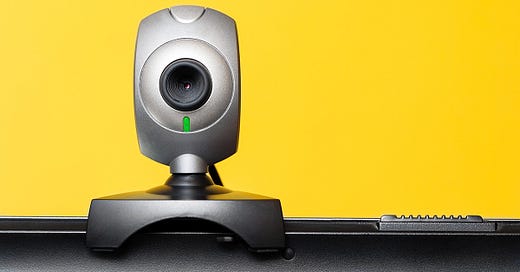Marketing BS: Employee Career Elasticity
Good morning everyone,
I hope you’re enjoying the first few weeks of 2022.
I’m happy to share my first-in-a-while essay — a look at employee surveillance and compensation.
If you missed my Whole New Year Briefing last week, you can check out some nuggets on target audiences, NPS, personalization, and more.
— Edward
Supervision and surveillance
Paying attention to employees is a core responsibility for any manager. Supervision was so much easier when managers sat right next to their employees, or at least worked in the same physical building. With the move to remote work, managers obviously have less daily contact with their employees.
In a previous essay (“Inputs and Outputs”), I discussed some new research about the productivity of remote work. Here were two key points:
For jobs that (1) do not require a great deal of innovation or collaboration, and (2) have clearly measurable outputs (e.g., the number of claims adjusted per day), it seems that working remotely increases average productivity.
But for jobs that (1) require innovative thinking or cross-team collaboration, and (2) have nebulous tracking metrics, the long-term impact of remote work is still an open question.
So what’s a manager supposed to do when they can no longer see (in-person) inputs AND they don’t have (useful) outputs to track?
One solution is rising in popularity: using technology to remotely monitor employees. Surveillance software can tell you which websites your employees are visiting, how many emails they are sending, how much time they are spending at their desk, and even how often they are moving their mouse. While surveillance software might seem creepy to many American and European white-collar employees, this type of digital monitoring has been commonly used in other parts of the world for years — especially on platforms for remote contractors (like Upwork, etc.).
You can find similar surveillance practices at any high-performance call center. Efficient call centers monitor every team member on a dashboard that tracks various metrics:
Percentage of working time available to take calls
Average handle time per call
Revenue generated per call
Percentage of customers churned per call
Average follow-up time spent post call
Average post-call customer satisfaction
With these detailed output metrics, you don’t really need to measure the input of an employee. But it still happens. In fact, good call center training programs will listen to a random assortment of each team member’s recorded phone calls and “score” them on a standardized rubric. Managers will use these calls to coach individual employees on ways to improve their scores. (In addition, call center operations analysts will examine the calls of top-performing agents to see what can be learned and shared with the rest of the workforce).
The quantification of labor may seem dehumanizing — and for many people, it is. But for the top-performing agents, being recognized (and compensated) for your output is a much better situation than being judged on how much your manager likes your personality.
The surveillance companies themselves try to put a positive spin on their software. Here’s what Del Currie, the co-founder of Sneek, says about his surveillance software: “The purpose of Sneek isn’t surveillance, but office culture… While some may be put off by the software’s interface, it’s meant to build a connected office dynamic”. (Maybe he should have thought about the negative perceptions before he named his product “Sneek”).
A few months ago, the European Union published a report on the state of remote employee monitoring. Here is a key section from the abstract:
This report re-evaluates the literature about surveillance/monitoring in the standard workplace, in home working during the COVID 19 pandemic and in respect of digital platform work... A total of 398 articles were identified, evaluated and synthesised. The report finds that worker surveillance practices have extended to cover many different features of the employees as they work. Surveillance in the workplace targets thoughts, feelings and physiology, location and movement, task performance and professional profile and reputation. In the standard workplace, more aspects of employees’ lives are made visible to managers through data… The surveillance of employees working remotely during the pandemic has intensified, with the accelerated deployment of keystroke, webcam, desktop and email monitoring… Excessive monitoring has negative psycho-social consequences including increased resistance, decreased job satisfaction, increased stress, decreased organisational commitment and increased turnover propensity.
In summary (from the full report):
Remote, “technological” monitoring has increased during the pandemic. Searches for HOW to monitor employees grew ~10x. Revenue of the larger employee-monitoring companies grew ~3x. The number of companies monitoring employees grew ~2x.
Monitoring itself tends to result in more “visibility” for managers,
But most managers do not know how to use the data well,
And many employees do not like being monitored — especially “input monitoring” (i.e., how they are doing their job) as opposed to “output monitoring” (which tasks were completed).
Executives and janitors
Employee surveillance is growing in popularity but notice who is — and isn’t — being monitored. Financially, you could understand the logic of tracking a company’s highest-paid employees, rather than entry-level or lower-skilled ones. You would think that ensuring a $500/hour employee does not waste an hour is more important for a company than monitoring the productivity of people who earn $10/hour.
Of course, we all know that’s not the way things are unfolding. Companies aren’t tracking their senior employees, even though that is where more dollars could be saved. I think it’s worth pausing to ask why surveillance started with call center agents and low-priced overseas work, before moving UP the corporate ladder? Two reasons:
Expensive employees have long-impact horizons, which means it takes more time to measure their impact (or lack thereof).
Expensive employees are expensive to acquire, and easy to lose.
The first reason is exemplified by the problem of judging a senior executive based on how much time they take for lunch. A shorter break might allow for more time at the computer doing “senior executive stuff.” But if a longer lunch improves the executive’s insights by 1%, then the company might benefit FAR more than it would by worrying about hourly productivity.
The second — and maybe more important — reason is pretty obvious: high-wage employees don’t want to be surveilled. Plus, high-wage employees (generally) have more career options and are harder to replace than low-wage workers.
But the continued impact of the pandemic has shifted the power in some industries, especially ones facing a labor shortage. During 2021, many US hospitals mandated vaccines for their entire staff. The “zero tolerance” policy for non-vaccinated employees started to shift in early December last year, as noted by the Wall Street Journal:
Some of the largest U.S. hospital systems have dropped Covid-19 vaccine mandates for staff after a federal judge temporarily halted a Biden administration mandate that healthcare workers get the shots.
Hospital operators including HCA Healthcare Inc. and Tenet Healthcare Corp. as well as nonprofits AdventHealth and the Cleveland Clinic are dropping the mandates.
Labor costs in the industry have soared, and hospitals struggled to retain enough nurses, technicians and even janitors to handle higher hospitalizations in recent months as the Delta variant raged. Vaccine mandates have been a factor constraining the supply of healthcare workers, according to hospital executives, public-health authorities and nursing groups.
Janitors would generally fall under the category of “low-skilled labor” that is subject to the whims of management. Like Amazon warehouse employees, janitors could have their work performance monitored and measured. But due to the labor shortage, janitors are actually receiving MORE autonomy, not less.
Meanwhile, the US Air Force has not backed down on its vaccine mandate; in fact, there has been almost 100% compliance. On the exact same day the WSJ published their article about hospitals walking back their mandates, PBS ran a story on the US military titled, “Air Force discharges 27 for refusal to get COVID vaccine.” To put the 27 discharges in context, during the first nine months of 2021, over 1800 airmen were discharged for failure to follow other orders.
What’s the difference between hospital janitors and enlisted airmen? No one is arguing that janitors are more highly skilled or possess better long-term career prospects. The difference in their vaccine compliance was entirely driven by the relative negotiating position of the two sets of workers. A dishonorably discharged member of the Air Force will (probably) struggle to find a new job with similar pay and benefits. A terminated-by-mandate hospital janitor, on the other hand, might find that other companies are rolling out the red carpet with job offers.
Demand and compensation
Hospital janitors aren’t the only job in high demand right now. Software engineers and tech executives are an incredibly hot commodity.
Levels.fyi is a tool that crowdsources compensation packages for various levels of seniority in the tech ecosystem. The company recently released their “End of Year Pay Report 2021,” which was nicely summarized by Byrne Hobart in The Diff:
The headline number is that entry-level software engineers at the top-paying tech companies are getting offers in the $200-250k range, with senior engineers who have over fifteen years of experience earning $650k-$1.2m… Comp has been rising, at both the bottom and the top. From 2019 to 2021, the highest entry-level salary rose from $234k to $250k, or 3.4% annualized, while the #5-ranked comp rose from $175k to $226k, or 14%. At the highest level, Facebook was offering E7s $950k all-in in 2019, and Roblox is paying TD1s $1.2m, 12% annualized growth. The comp package at the #5 spot for the most senior engineers was $533k in 2019 and is now $750k, or +19%
The trend is clear: the size of total compensation packages is increasing rapidly, with the most senior roles accelerating the most.
Tech companies that are not increasing pay fast enough are taking a hit. The WSJ reported that Microsoft’s Augmented Reality team has recently lost 100 senior engineers to Meta. More broadly, Microsoft has 66,000 open positions, equating to 35% of its existing staff. To help stem the losses, the company has initiated quarterly “career check-ins.”
The labor crunch, of course, is impacting companies beyond Microsoft. Even Meta — the beneficiary of the 100 Microsoft AR defections — has its own problems. As noted by a January 13 article in Bloomberg:
Facebook parent Meta Platforms Inc. was ranked as the 47th best place to work by Glassdoor this week in its annual list of 100 best companies to work for. That’s the lowest Meta has been since Glassdoor started keeping score. The company has taken the No. 1 spot three times, and last year was No. 11.
It’s hard to keep a spouse happy when they are being constantly serenaded by a rival who is offering more, more, and more.
In an environment like this, the idea that executives should start monitoring employees with surveillance software seems laughable. According to a piece in The Information, many of these companies are not even going to attempt to bring people back into the office. Whatever long-term productivity benefits a company might enjoy from in-person collaboration, the short-term cost of turning off prospective employees — many of whom desire freedom and autonomy — is just too big a risk.
Back in July 2019, I started writing about ways that companies are choosing to focus more and more on “marketing to employees.” The parallel trends of surveillance software and increased employee leverage show that it’s not ALL employees that companies want to market to. Companies care the most about the employees with the highest risk of leaving — the people with high “career elasticity.”
Keep it simple,
Edward
Edward Nevraumont is a Senior Advisor with Warburg Pincus. The former CMO of General Assembly and A Place for Mom, Edward previously worked at Expedia and McKinsey & Company. For more information, including details about his latest book, check out Marketing BS.





